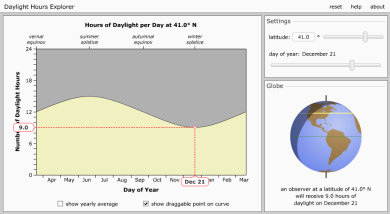It might be best to wait to click on the image below till after reading this post. Clicking on the diagram will take you to an interactive link, created by UNL Astromony, which illustrates the changing hours of daylight through the seasons.

The constellations of stars, which are light years distant from our solar system, are markers sometimes confused with the signs of the zodiac. The signs of the zodiac actually refer to our relationship to the sun, as we on the top half of the tilted globe 'face away' from the solar heat in the winter and 'lean into' it in the summer.
The more northerly the position on the globe, the more pronounced become the peaks and valleys seen in the illustration. When you click on the diagram and go to the link, you can click on the lines to alter the values and see how the amount of daylight is proportioned depending on time of year (which is really location with respect to sun) and latitude on globe.
For instance people in Ecuador, a country which straddles the equator, do not experience a significant change in daylight hours from one station (such as winter solstice, spring equinox, etc) to the next; while the folks in Ohio at about 41 North latitude have a peak of 15 daylight hours in summer which dwindles to only 9 hours in winter. Those in Alaska have almost continuous daylight in summer and nearly unremitting darkness in winter.
It is hard to believe, but I can testify! On a summer vacation to Alaska 20 years ago I climbed a small mountain in Denali Park with my boyfriend; we reached the peak at 10:00pm and the sun was only as low in the western sky as it would have appeared in my home state (North Carolina) at 6:00pm in August, providing plenty of light to get an intimate look at a moose that we encountered on our way back down. By 11:30pm, when we returned to the camper, the sun had finally 'set', but there was still so much light coming over the horizon that when we went to bed it was like taking a nap in the late afternoon. The sky never even became dark enough to be called twilight.
The zodiac signs are really just the four stations, or seasons, each divided into three equal sections. Though the constellations can be used as markers, it is essential to remember that since they drift backwards at a relatively slow rate of about 1 degree every 72 years*, they will be off by a whole constellation from where they were 20 centuries ago when the modern zodiac was defined. So, though the sun on the spring equinox is at the beginning of the sign Aries, it will be seen near the beginning of the constellation Pisces.
In response to the recent headlines about a thirteenth sign; yes, there are other constellations in the elliptical belt which were named and recorded throughout the history of 'western thought', but they were not included in the earth-sun based zodiac which is the root of modern astrology.
*Precession of the equinoxes Click here for --> wikipedia definition of Precession of Equinoxes
